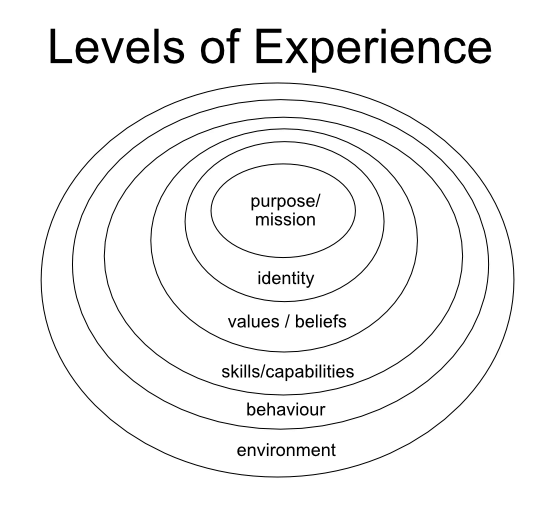title: “Levels of Experience”
we experience the world on a number of different levels
- How people experience the world
- LEVELS OF EXPERIENCE
- An Example: The European Community
- Benefits of sorting using the levels of experience
How people experience the world
People experience things at different levels; e.g., getting married vs. eating a meal. The same person will experience moving their desk vs. moving jobs. Likewise, different people can experience the same event quite differently. We have borrowed this model because it is useful. Some people think of this as going to higher levels (the mountain); others as going deeper (the well).
LEVELS OF EXPERIENCE
Levels of experience is a model used to sort data into that gives a rich picture of the current and future states of an organization. The data we have gathered fits in one of the logical levels, and the relationships between these levels makes it clearer what people meant. Often two or more pieces of data may seem contradictory, but when sorted into logical levels make sense. Likewise, one can use the sorting to gain an understanding of the magnitude and type of change needed. In addition, threads of change become clearer, with various pieces of data at different logical levels supporting each other.

From bottom to top, or from the outside in, the levels are:
Environment
What do people live in? Live with?
Examples
- work cubicles are 8 x 8
- organization is geographically dispersed
- more demand than time available
Behavior
What are people doing? Seeing? Hearing?
Examples
- people come in on weekends
- hall discussions are animated, exciting
- people normally arrive at meetings 10 minutes late
Skills/Capabilities
What can people do? Capabilities are learned, repeated, consistent actions.
Examples
- engineers know how to code in C++
- managers can create realistic schedules
- people can form teams quickly
Values/beliefs
What do people think is important?
Examples
- the work we do is important
- it is hard to change this place
- nobody beats us
- trust and respect for individuals
- achievement and contribution
- uncompromising integrity
- teamwork
- flexibility and innovation
Values and beliefs are principles that guide our actions and determine how we view ourselves, how we react to others, and what we make of our experience. Think about the rewards that really matter to people. Is it money? Doing something interesting? Learning? Being part of something important? A particular label, such as a title? Contributing to a particular mission? What is the organization rewarding?
What is often interesting is determine the difference between expressed values and practiced values.
Identity
Who are they as a group?
Examples
- we are the fastest ship in the fleet
- we are firefighters
- we are the Redwoods in this forest
Identity is frequently expressed as a metaphor, e.g., a real estate company that called themselves the IBM of real estate.
Purpose/mission
Why does the organization exist?
Examples
- we make systems work
- we keep the automotive customers with HP
- we give our customers solutions to their printing needs
An Example: The European Community
The European Community is trying to align different European countries by working at the environment and behavior levels (defining size of bananas, meat content of sausage, or setting tax levels or standard working hours). What would it be like if EC focused on establishing a mission for Europe as a trading block or defined values such as protecting the oil industry or investing in new high technology?
Benefits of sorting using the levels of experience
Is there alignment within the organization for the desired state? If not, need to start there. Designing: if it’s greenfield you can start with mission and who do you need to be, etc. The question “What does that get you?” generally raises the answer one level. The cost of change, how big the change is, how hard it is, how long it might take, the risk involved. For example, just a capability change vs. values and beliefs vs. identity